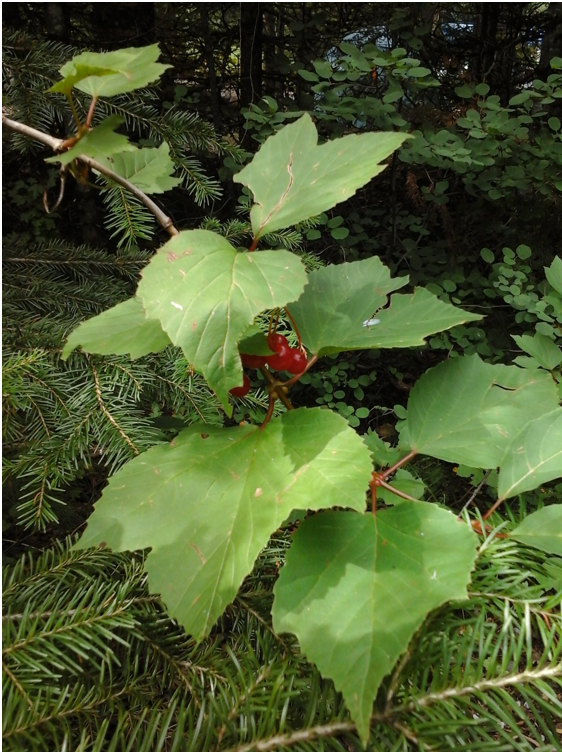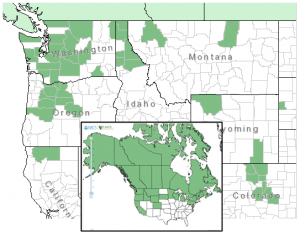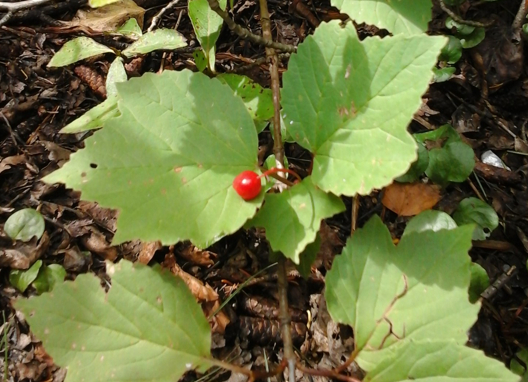High Bush Cranberry
Viburnum edule (Michx.) Raf. Caprifoliaceae-the Honeysuckle Family
(Vi-BUR-num ED-yew-lee) (Newer classification Adoxaceae-the Moschatel Family)

Names: The name Viburnum comes from the Latin word for Viburnum lantana, the Wayfaring Tree. Highbush Cranberry is also known as Squashberry, Mooseberry, Moosewood Viburnum, Lowbush Cranberry, Few-flowered Highbush Cranberry, Pembina, Pimbina, or Moosomin ( in Cree Language). It has also been known as V. opulus var. edule and V. pauciflorum (meaning few-flowered). Edule means edible. Highbush Cranberries get their name from their cranberry-like red berries that grow on tall shrubs, in contrast to true cranberry plants, Vaccinium (Oxycoccus) sp. which are small creeping shrubs or vines.
Relationships: There are about 150-175 species of Viburnum in temperate regions of the Northern Hemisphere with a few species found in mountainous regions of South America, Southeast Asia & Africa (in the Atlas Mountains). There are about 20 native to North America. Many species are popular garden and landscape plants. Several hybrids and cultivated varieties. have been developed. They are grown for their flower display and/or showy fruit, Some have fragrant flowers; some with attractive or unusual evergreen leaves or fall color.

Distribution of Highbush Cranberry from USDA Plants Database
Distribution: High Bush Cranberry is found all across the northern United States and Canada; from Alaska to central Oregon in the west. It is listed as endangered in Wisconsin; threatened in Michigan, New York, and Vermont; and of ‘Special Concern’ in Maine.
Growth: High Bush Cranberry grows 1.5-9 feet (.5-3 m) tall.
Habitat: It is found in moist woods, forest edges, rocky slopes, along streams, and in swamps. Wetland designation: FACW, It usually occurs in wetlands, but is occasionally found in non-wetlands.
Diagnostic Characters: Its leaves are opposite, usually shallowly palmately 3- lobed and sharply toothed; sometimes looking almost like a dinosaur footprint. The white flowers are all alike in small clusters, with no ring of sterile flowers. Fruits are red or orange berry-like drupes, each with a large flattened stone. Bark is smooth and reddish-gray.

In the Landscape: Highbush Cranberry has attractive flowers and fruit, and brilliantly colored foliage in the fall. It is one of the most sought after shrubs for the wildlife gardener to attract birds to their garden. The tart berries may be enjoyed by both people and wildlife.
Phenology: Bloom time: May-July; Fruit ripens: Late summer persisting through winter.
Propagation: Seed is best sown in a cold frame as soon as it is ripe; it may take more than 18 months to germinate. Stored seed requires 2 months warm and 3 months cold stratification and may still take 18 months or more to germinate. Cuttings are easier. Softwood cuttings may be taken in early summer; half-ripe wood in July or August; or mature wood in winter. Layering is also possible.
Use by People: The tart fruits were an important food to many tribes. They were harvested, sometimes while still greenish, or later after the first frost, and stored in boxes with water and oil; becoming softer and sweeter over time. They were sometimes dried. The fruits make excellent jams, jellies, juices, or sauces. Pojar & Mackinnon state: “When mixed half-and-half with commercial cranberries, they make an excellent Thanksgiving cranberry sauce.” Raw fruit can cause nausea in some people if it is eaten in large quantities. The bark was taken for coughs and digestive disorders; leaves and twigs were used to make a gargle for sore throats. The stems were used for birch bark basket rims.
Use by Wildlife: Highbush Cranberries are eaten by bears and many small mammals and birds. Foliage is browsed by elk, Bighorn Sheep, deer, moose, caribou, beaver, rabbit, and snowshoe hare. The plant also provides cover for small mammals and birds. Butterflies visit the flowers.
Links:
Consortium of Pacific Northwest Herbaria
WTU Herbarium Image Collection, Plants of Washington, Burke Museum
E-Flora BC, Electronic Atlas of the Flora of British Columbia
Ladybird Johnson Wildflower Center
USDA Forest Service-Fire Effects Information System
Native Plants Network, Propagation Protocol Database
Native American Ethnobotany, University of Michigan, Dearborn
